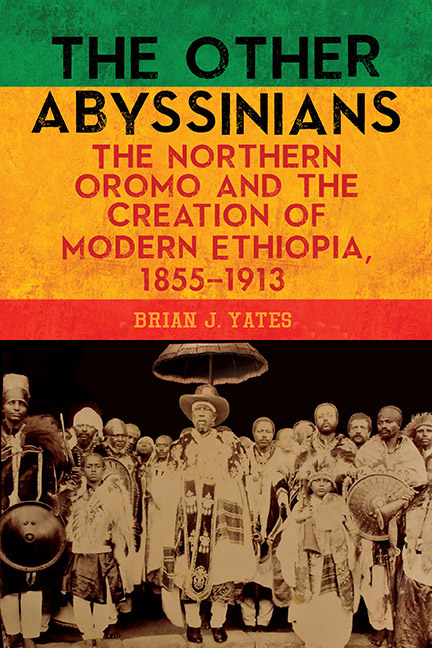Book contents
- Frontmatter
- Contents
- Preface
- Introduction: What about the Oromo Habäsha? Liberating Northern Oromo Experience from Competing Nationalisms
- 1 Cultural Backgrounds and the Habäsha State
- 2 In but not of: The (Re)Integration of the Wällo Oromo into the Habäsha Community
- 3 Menilek, Gobäna, and the Creation of Habäsha Shäwa, 1855–88
- 4 Recreating the Autonomy of Wällo: The Unions of Mikaél and Menilek
- 5 From Personal Relationships to a Centralizing State: Shäwan Ethiopia (1889–1913)
- Conclusion: The Oromo Habäsha in Modern Ethiopia
- Appendix A Guide to the Transliteration of the Ethiopic Script to the Latin Script
- Appendix B Glossary of Ethiopian Terms
- Appendix C Sample Interview Questions for Shäwa and Wällo
- Notes
- Bibliography
- Index
Conclusion: The Oromo Habäsha in Modern Ethiopia
Published online by Cambridge University Press: 21 March 2020
- Frontmatter
- Contents
- Preface
- Introduction: What about the Oromo Habäsha? Liberating Northern Oromo Experience from Competing Nationalisms
- 1 Cultural Backgrounds and the Habäsha State
- 2 In but not of: The (Re)Integration of the Wällo Oromo into the Habäsha Community
- 3 Menilek, Gobäna, and the Creation of Habäsha Shäwa, 1855–88
- 4 Recreating the Autonomy of Wällo: The Unions of Mikaél and Menilek
- 5 From Personal Relationships to a Centralizing State: Shäwan Ethiopia (1889–1913)
- Conclusion: The Oromo Habäsha in Modern Ethiopia
- Appendix A Guide to the Transliteration of the Ethiopic Script to the Latin Script
- Appendix B Glossary of Ethiopian Terms
- Appendix C Sample Interview Questions for Shäwa and Wällo
- Notes
- Bibliography
- Index
Summary
One of the key challenges in modernizing Ethiopia was institutionalizing personal alliances. The ascent of Lej Iyasu provides evidence for continued systematic integration of Oromo groups that became Habäsha over the last century. Previous studies characterize his reign to underscore the view of Ethiopia as an ethnocentric and Islamophobic nation. The increasing attention to his reign reveals the complexity of both the Ethiopian people and the state that they created. Lej Iyasu Mikaél was another product of the political marriages common in this era. His mother, Shäwarägga, daughter of Menilek II, was first married to Ras Gobäna's son, Wadajo, producing Wässan Säggäd. Later, she was married to Ras Mikaél, Iyasu's father. While he was raised in Shäwa and tutored by Germans, Iyasu remained close with his father and his father's province. As a child of Wällo and Shäwa, he became a symbol of the union of these two lands, which resulted in the foundation of modern Ethiopia and the culmination of decades of interactions between Menilek and this province. Iyasu was not Menilek's initial choice; many thought his cousin Ras Mäkonnen would succeed him. Menilek himself favored another grandson, Wässan Säggäd Wadajo Gobäna, whom he raised in his palace until his death in 1900 at age 18. This Shäwan, who was also a grandson of a self-made Shäwan military commander, Ras Gobäna, was a candidate would have eased the concerns of the conservative Shäwan elite. Upon his death, Iyasu was brought to the palace and soon became Menilek's heir.
This work began with a revaluation of historical identities in Ethiopia and argued for a culturally dynamic, inclusive, community-based identity as opposed to the exclusive, static ethnic identities that dominate Ethiopian studies. It did so using Wällo and Shäwa as case studies to obtain not only a better understanding of the Ethiopian past but also an idea of how many identities have been created across the diverse continent of Africa. What appeared to twentieth-century historians as a wholly Amhara state, led by a quintessential Amhara, Haylä Sellassé, is actually a syncretic state as diverse as its leadership. The creation of this state and its leaders utilized cultural practices aimed at increasing interactions between local groups.
- Type
- Chapter
- Information
- The Other AbyssiniansThe Northern Oromo and the Creation of Modern Ethiopia, 1855-1913, pp. 133 - 138Publisher: Boydell & BrewerPrint publication year: 2020



